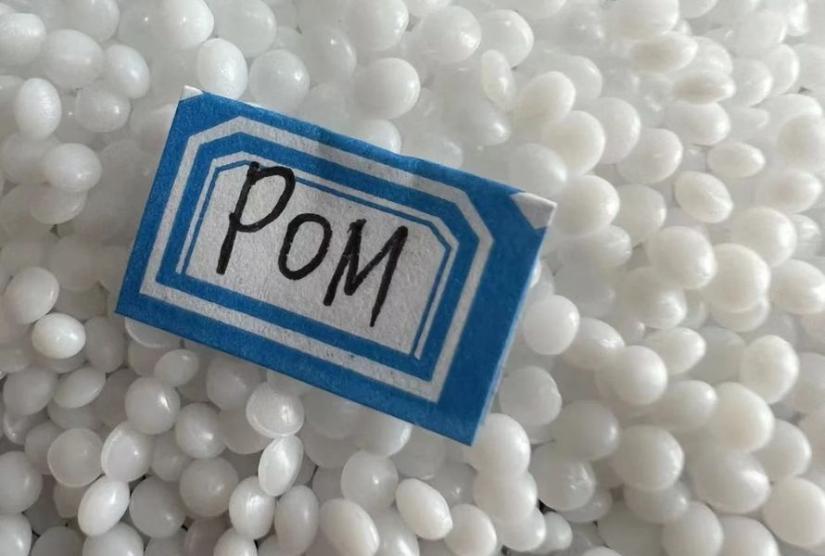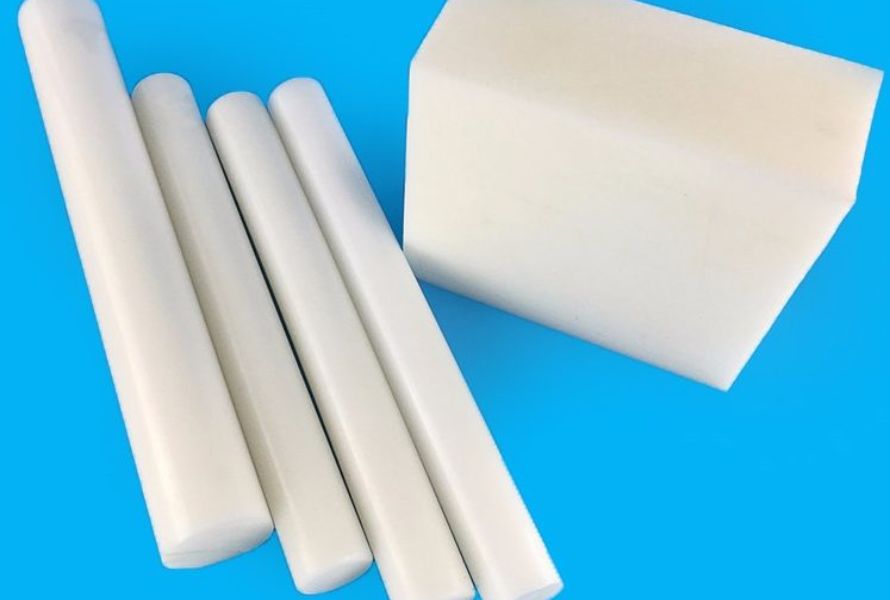1. What is POM plastic?
What is POM material? Polyoxymethylene (POM), also known as acetal or polyacetal, is an engineering thermoplastic with exceptional properties. POM is commonly used in the production of precision parts that demand high stiffness, low friction, and dimensional stability. Like many other synthetic POM polymers, it is manufactured by various chemical companies using slightly different formulations and marketed under different names such as Delrin, Kocetal, Ultraform, Celcon, Ramtal, Duracon, Kepital, Polypenco, Tenac, and Hostaform.
POM plastic material exhibits high strength, hardness, and rigidity even at temperatures as low as -40 °C. It naturally has an opaque white appearance due to its high crystalline content, although it can be produced in a range of colors. The density of POM ranges from 1.410 to 1.420 g/cm3.
In approximately 1952, a group of research chemists at DuPont successfully synthesized a variant of POM. Four years later, in 1956, the company filed for a patent to protect the homopolymer form.
Group of research chemists at DuPont officially recognizes R. N. MacDonald as the inventor of high-molecular-weight POM.
Patents filed by MacDonald and his colleagues outline the process for creating high-molecular-weight hemiacetal-terminated (~O−CH2OH) POM. However, these versions lack the necessary thermal stability to be commercially viable.
The credit for developing a heat-stable and therefore commercially useful POM homopolymer goes to Stephen Dal Nogare. He discovered that by reacting the hemiacetal ends with acetic anhydride, the easily depolymerizable hemiacetal could be transformed into a thermally stable plastic that can be melted and processed.
POM is a high-performance engineering thermoplastic that exhibits excellent mechanical POM material properties, low friction coefficient, and good dimensional stability.
POM is characterized by its high strength, stiffness, and hardness, making it suitable for various applications that require these properties. It has a low coefficient of friction, which makes it ideal for components that require sliding or rotating movements, such as gears, bearings, and bushings.

What is POM plastic?
2. Properties of POM plastic
Polyoxymethylene (POM), alternatively referred to as acetal or polyacetal, is a high-performance engineering plastic that finds extensive application across various industries. It possesses a range of unique characteristics that make it suitable for a wide array of applications.
High Mechanical Strength
POM plastics are recognized for their remarkable mechanical strength. It exhibits excellent tensile strength, allowing it to withstand heavy loads and resist deformation.
Low Friction and Wear Resistance
A notable property of POM plastic is its low coefficient of friction, which contributes to its exceptional self-lubricating characteristics. The low frictional resistance enables smooth sliding or rotating movements, reducing wear and enhancing the overall performance and efficiency of applications.
Dimensional Stability
POM plastic exhibits excellent dimensional stability, maintaining its shape and size under varying temperature and humidity conditions. It has low moisture absorption, reducing the risk of dimensional changes caused by moisture exposure. The dimensional stability of POM is crucial in applications where precise tolerances and consistent performance are required, such as precision instruments and electrical connectors.
Chemical Resistance
POM plastic demonstrates remarkable resistance to various chemicals, solvents, and fuels. It can withstand exposure to oils, greases, alcohols, and many organic compounds without significant degradation. This property makes POM suitable for applications where contact with chemicals is inevitable, such as fuel system components, pump parts, and seals.

Properties of POM plastic
Good Electrical Insulation
POM plastics possess excellent electrical insulation properties, making it valuable in electrical and electronic applications. It has a low dielectric constant and dissipation factor, allowing it to insulate and protect electrical components effectively.
Easy Machinability
POM plastic is known for its ease of machinability, enabling efficient and precise manufacturing processes. It can be readily shaped, milled, turned, and drilled, allowing for complex designs and intricate parts to be produced with ease. This property makes POM resin a preferred choice for applications that require intricate geometries and high precision, reducing production time and costs.
Thermal Stability
One of the key advantages of POM plastic is its remarkable thermal stability, enabling it to withstand a wide range of temperatures without undergoing significant changes to its properties. It has a high melting point and can handle both high and low temperatures, making it suitable for applications in extreme environments.
Low Water Absorption
POM plastic has low water absorption properties, making it resistant to moisture-related issues such as swelling, warping, or dimensional changes. This property ensures that products made from plastic POM retain their shape and dimensions even in humid or wet conditions.
Excellent Chemical Stability
POM plastic demonstrates exceptional chemical stability, maintaining its integrity when exposed to various chemicals and solvents. It resists degradation and remains unaffected by many common chemicals, including acids, bases, and organic solvents.
Low Coefficient of Thermal Expansion
POM plastic has a relatively low coefficient of thermal expansion, meaning it expands and contracts less with temperature changes compared to other materials. This property contributes to its dimensional stability and ensures that POM-based products maintain their shape and size over a wide range of temperatures.
Good Creep Resistance
POM plastic exhibits excellent creep resistance, meaning it resists deformation under prolonged mechanical stress. This property allows POM components to maintain their shape and performance over extended periods, even when subjected to continuous loads or stresses.

Properties of POM plastic
3. Common applications of POM material
Polyoxymethylene (POM), also known as POM acetal or Delrin, is a versatile engineering thermoplastic POM that offers several beneficial properties, such as high stiffness, low friction, excellent dimensional stability, and good chemical resistance. These characteristics make POM suitable for various applications across different industries. Here are some common applications of POM material:
Automotive Industry: POM is widely used in automotive applications due to its excellent mechanical properties. It is used in fuel system components, gears, bushings, clips, valves, and other precision parts. POM's low friction and wear resistance make it suitable for applications like gears, where smooth operation and durability are essential.
Electrical Industry: POM's electrical insulation properties and dimensional stability make it suitable for electrical applications. It is used in connectors, switches, relay housings, insulating components, and other electrical parts that require good dielectric properties and resistance to moisture and chemicals.
Consumer Goods: POM finds extensive use in the consumer goods industry. It is employed in various applications such as zippers, buckles, handles, knobs, fasteners, and toys. POM's durability, low friction, and ability to withstand repeated use make it suitable for these applications.
Medical and Healthcare: POM's biocompatibility, stabilizability, and resistance to chemicals make it suitable for medical and healthcare applications. It is used in surgical instruments, drug delivery devices, orthopedic implants, dental components, and other medical equipment.
Industrial Machinery: POM's high mechanical strength and resistance to wear make it suitable for various industrial machinery applications. It is used in gears, bearings, conveyor system components, valve parts, and other precision mechanical parts that require high strength, low friction, and dimensional stability.
Fluid Handling Systems: POM's chemical resistance, low moisture absorption, and dimensional stability make it suitable for fluid handling systems. It is used in pumps, valves, impellers, fittings, and other components that come into contact with chemicals, fuels, or corrosive fluids.
Packaging Industry: POM is utilized in the packaging industry for manufacturing bottle caps, closures, and dispenser components. Its strength, dimensional stability, and resistance to chemicals make it suitable for these applications.
Sports and Recreation: POM is used in sports and recreational equipment such as ski bindings, archery bow components, gears and cams in bicycles, and various outdoor equipment. Its toughness, low friction, and resistance to impact make it suitable for these applications.

Common applications of POM material






